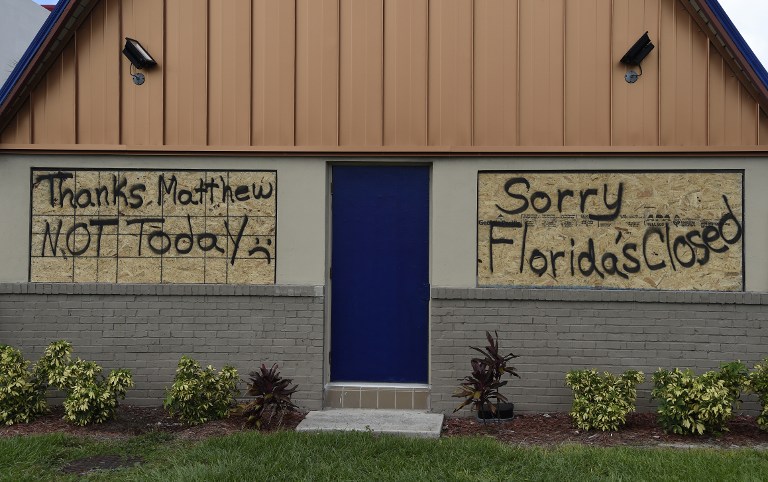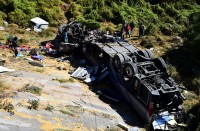
Hurricane Matthew, the Caribbean’s worst storm in nearly a decade, barreled towards the Bahamas Wednesday morning after killing nine people and pummeling Haiti and Cuba. Far to the north, the first evacuations were ordered in the United States as coastal residents prepared to escape the approaching monster storm, expected off the East Coast later this week.
/ AFP PHOTO / RHONA WISE
MIAMI, United States (AFP) – by Kerry SHERIDAN with Daniel Woolls in Washington
Residents of the US state of Florida scrambled to escape the path of Hurricane Matthews on Thursday as it pounded the Bahamas after leaving 27 people dead in the Caribbean.
The storm, which is swirling near the northwest Bahamas, is expected to intensify to a Category Four hurricane as it moves northwest towards Florida.
Matthew, the worst storm to hit the Caribbean in nearly a decade, has already forced the closure of airports in the Bahamas, with cruise ships re-routed from the popular tourist destination, the government said.
“Seriously consider now moving to higher grounds,” Bahamian Prime Minister Perry Christie told southern coastal communities before the storm hit.
In its latest bulletin, the US-based National Hurricane Center reported that hurricane conditions were expected to reach Florida by late Thursday.
“This hurricane is life-threatening. Listen to your local officials and follow evacuation notices,” Florida Governor Rick Scott said on Twitter.
US President Barack Obama warned Americans in the storm’s path to take the threat seriously.
“We hope for the best, but we want to prepare for the worst,” he said.
The storm slammed into Haiti and Cuba as a Category Four hurricane on Tuesday but has since been downgraded to three, on a scale of five, by the NHC.
Matthew was packing maximum sustained winds of 12 miles (19 kilometers) per hour as it swirled some 60 miles southeast of Nassau at 0900 GMT.
‘Prepare for direct hit’
The hurricane is expected to move “very close to the east coast of the Florida peninsula” Thursday through Friday, the NHC said.
“Everyone in our state must prepare now for a direct hit,” said Governor Rick Scott, as evacuation orders were issued.
Schools and universities closed for the rest of the week, authorities were distributing sandbags for doorways, and store shelves were bare.
“We’re not really afraid, Florida has been through this thing for years,” said Rick Basel, 63, a retiree loading his car with food and water to last three or four days.
Further north in South Carolina, Governor Nikki Haley ordered the evacuation of several coastal counties — with more than a million people affected.
The order included the historic city of Charleston, a tourist magnet boasting cobblestone streets lined with graceful antebellum homes.
News footage showed bumper to bumper jams on highways and tensions were high as some gas stations ran out of fuel.
‘Nothing left’
As Matthew barreled northwest, Haiti and Cuba began the grim task of assessing the storm’s toll.
Matthew’s death toll stood at 27 — 23 in Haiti and four in the Dominican Republic — but this looked certain to climb.
Civil protection spokesman Edgar Celestin said the figures do not include data from the department of Grande Anse, which was in the eye of the storm and has been cut off from communication.
Haiti’s presidential election, scheduled for Sunday, has been postponed.
Interim president Jocelerme Privert, who surveyed damage to southern Haiti Wednesday in a US Coast Guard plane, called the situation “catastrophic.”
Matthew has knocked out a key bridge providing access to the country’s south where the storm made landfall.
The severe flooding has also sparked a resurgence of cholera, with eight cases already reported, officials said.
The United Nations office for coordinating humanitarian affairs said half of Haiti’s population of 11 million was expected to be affected.
At least 350,000 people in Haiti, where thousands have lived in tents since the massive earthquake in 2010, need immediate assistance, UN Secretary General Ban Ki-moon’s office said.
The US military said Wednesday it was sending helicopters, an aircraft carrier and troops to assist the aid effort in Haiti — which had not been hit by a Category Four storm in 52 years.
In Cuba, where some 1.3 million people were evacuated, there were no reported fatalities but four cities in the east were cut off because roads were blocked by large chunks of rock hurled by the storm.
Officials reported flooding and waves up to 16 feet (five meters) in eastern coastal villages and Baracoa, the first Spanish settlement in Cuba, was decimated.
“There’s nothing left of Baracoa. Just debris and remains,” said resident Quirenia Perez, 35, speaking to AFP by cell phone after losing her roof, electricity and landline in the storm.








